About the Substance Attributes
Material Editor > Create/Convert > Create Material > Substance
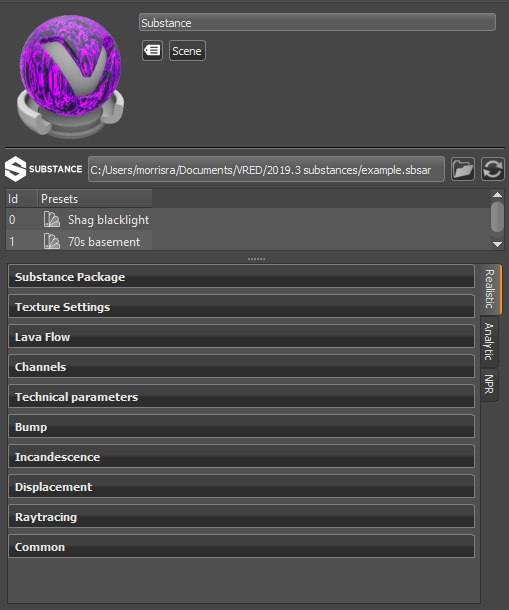
The Substance Attributes
The top part of the Substance Attributes displays a Material Preview and the following additional information:
-
Substance Name - Provides the name and location of the Substance.
-
 Load - Opens the Load Substance Archive dialog for locating a Substance. By default, it opens to the last opened directory.
Load - Opens the Load Substance Archive dialog for locating a Substance. By default, it opens to the last opened directory. -
 Reload - Reloads the Substance archive file.Important:
Reload - Reloads the Substance archive file.Important:Any previous changes made to the material are lost, including presets.
-
Id - Identifies the listed presets with a numeric value.
-
Presets - Displays the name of the listed Substance presets.
- Double-click LMB to apply the preset.
- Double-click MMB to apply the preset AND set the default output size.
Substance Parameters
This next section houses parameters. Most substances will have Substance Package, Texture Settings, Bump, Displacement, Raytracing, and Common parameter categories, along with their own unique categories of parameters. However, some of these may not exist for a given Substance and there may be some unique to it.
Supported Texture Channels
Here is a list of the supported Substance output channels:
- Base Color (Required)
- Roughness (Required)
- Metallic (Required)
- Normal (Optional) - VRED expects the normal texture to be generated in DirectX normal format (i.e., +X = right and +Y = down).
- Height (Optional)
- Emissive (Optional)
- Opacity (Optional)
- Specular Level (Optional)
- Ambient Occlusion (Optional)
- Anisotropy Level and Anisotropy Angle (Optional) - VRED uses the anisotropy angle for a clockwise rotation.
Here is a list of Texture Channels that are not easily found in VRED:
-
Normal is found in Bump (Bump Intensity). Tangent-space Normal mapping is used. Bump Intensity is set to 1.0 by default to enable normals. When Bump Intensity is set to 0.0, Normal mapping is disabled.
-
Height is found in Displacement. By default, Displacement mapping is disabled (Displacement Height is set to 0). To displace the geometry, based on the content of the height texture, set Displacement Height to a value greater than 0. The Displacement Offset defines the texture values used to extrude (values larger than Offset) or indent (values smaller than Offset) the geometry.
-
Height is also found in Bump (Parallax Intensity + Bump Type). Instead of using Displacement mapping, a method called Parallax Mapping is used to create the impression of a displaced surface.
Parallax mapping is faster than real displacement mapping; however, it does not generate the correct silhouettes and might display artifacts. By default, Parallax Mapping is disabled (Parallax Intensity is set to 0.0). Bump Type controls use the Parallax Mapping method. For example, the Bump Type, Bump Mapping, enables standard Parallax Mapping and Displacement Mapping enables Parallax Occlusion Mapping.
-
Emissive is found in Incandescence. If a material has an emissive texture, the Incandescence Intensity will be set to 1.0 by default.
-
Opacity is found in Transparency. The Use Cutout option will be enabled by default.
Substance Package
The following list is comprised of parameters we feel are notable:
-
Graph - Specifies the graph used by the Substance. Each graph can change the look and makeup of a Substance. Click the drop-down and select a graph.
- Reset - Resets the current selected graph to its default parameters. However, any VRED material setting changes made to Texture Settings, Bump, Incandescence, Displacement, Transparency, Raytracing, or Common will remain. See Resetting a Graph in Working with Substances.
-
Output Size - Sets the rendering output resolution for each Substance material. For a Substance that contains multiple materials, you can set some materials to a lower resolution, and others to a higher one. Doing this, enables you to control memory usage and reduce rendering time. Use the Lock feature to lock in the output size.
-
Random Seed - Randomizes the texture patterns within the Substance, based on the numeric value entered.
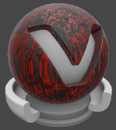
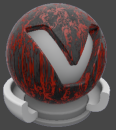
For the first image, Random Seed = 0. For the second, it is 30. Notice the difference in the texture pattern.
Environment Material
These attributes only appear when a Substance Environment is selected.
| 2021.3 Results | 2022 Results |
|---|---|
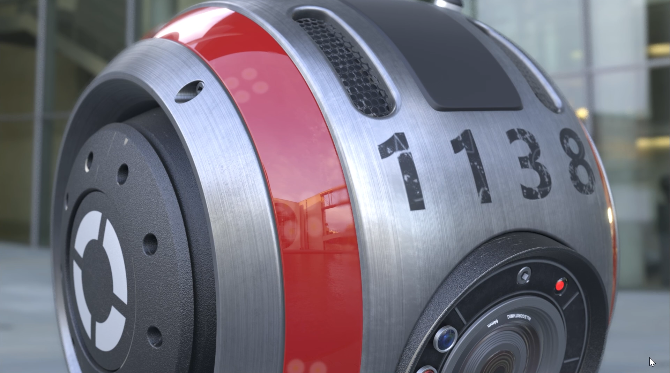 |
 |
-
Environment - Indicates the HDR used for the environment and improves the HDR environment sampling making realtime scenes look even more realistic.
-
 Loads an HDR. Clicking with the left mouse button opens a standard file dialog. Clicking with the right mouse button opens a special image file browser dialog.
Loads an HDR. Clicking with the left mouse button opens a standard file dialog. Clicking with the right mouse button opens a special image file browser dialog. -
 Saves the HDR.
Saves the HDR. -
 Reloads the HDR. To ensure you are using the most up-to-date HDR, click to load the latest version.
Reloads the HDR. To ensure you are using the most up-to-date HDR, click to load the latest version.
-
-
Glossy Quality - Defines the quality for the precomputed (pre-filterd) glossy image-based lighting (IBL) by using the set sample amount per pixel. Use these to control sampling values for environment map pre-computations for more accurate results.
Higher values provide better quality, but require longer pre-calculation time. It's also used for the precomputed raytracing mode, but not full global illumination.
Tip:Higher values provide better quality, but require longer pre-calculation time.
Choose from:
- Custom - Uses the values entered. The higher the value, the better the visual quality. The lower the value, the faster the computations.
- Low - Uses 256 samples.
- Medium - Uses 512 samples.
- High - Uses 1024 samples.
- Ultra High - Uses 2048 samples.
-
Environment Geometry - Selects the geometrical form for the current Substance environment.
- Custom: Loads an external geometry file.
- Dome
- Sphere
- Cube
-
Is Visible - Sets the light source to on, by default. Controls the visibility of the Substance environment within the render view. A hidden, but activated Substance environment furthermore influences all scene-contained objects, regarding their look and appearance.
-
Flip Inside Out - Flips the normals of the Substance environment.
-
Shadow Plane Visible - Enables or disables the shadow plane on the ground.
Shadows and Illumination
These attributes only appear when a Substance Environment is selected.
-
Shadow Lightsources - Sets the number of explicit light sources. There are 256 light sources available.
-
Use Lightsources Only - When selected, only the shadow lightsources used for the environment are used for illumination. At least one lightsource must be entered in the Shadow Lightsources option for results. In the Raytracing Settings tab, set Illumination to Full Sphere to get illumination from the floor.
-
Material Shadow Intensity - Sets how dark or intense the material shadows cast are and their color.
-
Ground Shadow Intensity - Sets how dark or intense the ground shadows cast are and their color.
-
Map Filter Radius - Sets the radius used for filtering the shadow map lookup in OpenGL.
-
Map Resolution - Sets the quality of OpenGL shadow maps. Higher values increase the quality.
Color Correction
These attributes only appear when a Substance Environment is selected.
-
Exposure - Sets the HDR-Image’s exposure level. The higher the exposure level, the longer the series of shutter cycles which are used to calculate the image’s light intensity.
-
Whitebalance - Sets the camera's white balancing color temperature. Lower values balance the camera to a lower color temperature and therefore create cooler (bluish) colors. A higher value balances the camera to a higher color temperature and produces a warmer (yellowish) color.
-
Hue-Shift - Shifts all colors in the HDR-Image uniformly through the hue color range.
-
Contrast - Separates the light and dark color values further from each other.
-
Brightness - Raises the color value of the whole HDR-Image.
-
Saturation - Sets the HDR-Image’s saturation.
-
Reflected Saturation - Sets the HDR-Image’s saturation when the HDR-Image reflects in any surface.
Transformation
These attributes only appear when a Substance Environment is selected.
The source of spherical projection of the Substance Environment Material can be set with transformation parameters.
-
Environment Size - Sets the radius of the Substance Environment Material’s projection sphere. The projection sphere must enclose all objects using a material having this Sphere Environment Material as environment shader assigned. All objects that are outside the projection sphere using a Truelight Material with this Substance Environment Material as input channel, are not rendered properly.
-
Center X, Y, Z - Defines the projection sphere’s center position.
-
Get from Object - Sets the projection sphere’s center. To center the projection pivot automatically, select an object and press Get Center. The selected object center is now used as projection spheres pivot.
-
Rotate X, Y, Z - Sets the Substance Environment Material’s orientation.
-
Scale X, Y, Z - Sets the Substance Environment Material’s size. With the scale value, the image projection can be stretched and squashed on any axis.
Raytracing Settings
These attributes only appear when a Substance Environment is selected and only take effect in Raytracing Mode.
-
Is Visible in Reflections - Sets the visibility.
-
Use as Lightsource - Uses the HDR ALS light source. Only supported in FullGI illumination mode.
-
Use Accurate Geometry - When selected, uses the accurate geometry. This option is unselected by default. If unselected, all diffuse and glossy reflection calculations are based on the virtual sphere of the environment. Selecting this option, the real environment geometry is used for more accurate diffuse and glossy illumination in Precomputed+IBL and Full Global Illumination Mode. (At the cost of a 20–25% performance hit compared to default finite sphere environment.)
Note:This option is only supported for diffuse and glossy environment reflections.
-
Emit Caustics - Activates/deactivates Emit Caustics. Allows the HDR to emit caustics. Only supported in FullGI illumination mode with caustics.
-
Material ID - Sets the id of the material.
-
Illumination - Offers the following options:
-
Upper Hemisphere - Emits light only from the top half of the sphere.
-
Full Sphere - Emits light from the whole sphere.
-
-
Override IBL Sampling Quality - If enabled, the setting overrides the global IBL Sampling quality for sampling the environment map.
-
Interactive Quality - Sets the IBL sampling quality during interactive rendering.
-
Still Frame Quality - Sets the IBL sampling quality during Still Frame rendering.
-
Texture Settings
The following are a list of the parameters:
-
Mapping Type - Sets how the Substance is mapped onto your geometry. Choose from UV, Planar, and Triplanar. Use this in combination with other Texture Settings such as Repeat Mode UV, and Texture Size to adjust your Substance to the geometry.
-
Repeat Mode UV - Sets the repeat mode of the texture.
-
Texture Size - Defines texture size in millimeters instead of repeat values for texture mapping.
-
X Repeat UV - Sets the repeat mode for the U and V-axis of the texture in X.
-
X Offset UV - Sets an offset for the UVs in X.
-
X Rotate - Rotates the UVs in X.
-
Y Repeat UV - Sets the repeat mode for the U and V-axis of the texture in Y.
-
Y Offset UV - Sets an offset for the UVs in Y.
-
Y Rotate - Rotates the UVs in Y.
-
Z Repeat UV - Sets the repeat mode for the U and V-axis of the texture in Z.
-
Z Offset UV - Sets an offset for the UVs in Z.
-
Z Rotate - Rotates the UVs in Z.
Bump
The following are a list of the parameters:
-
Parallax Intensity - Controls the degree of motion parallax applied to the substance.
-
Bump Intensity - Sets the prominence of the bumps of the substance. High intensity results in very prominent or high bumps.
-
Bump Type - Applies the chosen mapping setting to the substance, either bump or displacement mapping.
Transparency
- Use Cutout Transparency
Displacement
The following is a list of the parameters:
-
Displacement Height - Defines the scaling factor of values for the displacement.
-
Displacement Offset - Defines the offset of the displacement. Allows you to set the value of the zero plane in the texture. Values below the zero plane displace inside the geometry and values above the zero plane displace outside the geometry.
-
Use Accurate Silhouettes in OpenGL - Allows you to calculate the displacement in OpenGL like in raytracing mode. Selecting it may drastically reduce the performance.
Raytracing
The following are a list of the parameters:
-
Material ID - Sets the ID of the material.
-
Line Tube Radius - Defines the radius of the tube when the substance is applied to a line geometry.
-
Use Local Environment - Calculates the diffuse and glossy reflections from the environment assigned to this substance in all illumination modes.
-
Ignore Photon Map - Ignores the light values of a photon map when calculating the illumination of a pixel.
-
Override Illumination Mode - Overrides the global set illumination modes for interactive or still frame rendering.
-
Override IBL Sampling Quality - Overrides the global IBL sampling quality for sampling the environment map during interactive or still frame rendering.
-
Override Reflection/Refraction Sampling Quality - Overrides the global sampling quality for reflections and refractions during interactive or still frame rendering.
-
Override Trace Depth - Overrides the global set trace depth modes for interactive or still-frame rendering.
Rounded Edges
For more information on how to use the rounded edges parameters, see Rounded Edges Shader.
-
Mode - Sets how edges are smoothed. There are four options:
-
Off - No edge rounding; therefore, all other parameters are disabled.
-
Same Geometry - Only rounds edges belonging to the same geometry or shell.
-
Same Material - Only rounds edges between objects with the same material.
-
Same Group - Only rounds edges between materials with the same group ID. This can be useful for an eyeball and lid, where there are different materials, yet you want a smooth edge between them to catch the highlight.
-
-
Group - Available only when the Mode, Same Group, is chosen. Sets the group ID for smoothing.
-
Type - Sets the type of edges rounded. There are three options:
-
Convex & Concave - Both convex and concave edges are rounded.
-
Convex only - Only convex edges are rounded. This speeds up calculations when there are only convex edges.
-
Concave only - Only concave edges are rounded. This speeds up calculations when there are only concave edges.
-
-
Radius - Sets the radius for rounded edges in world space.
-
Chamfer - Gives the edge a more chamfered appearance, instead of a perfectly round shape.
-
Angle Limit - Limits the rounding effect to edges with an angle above the given limit. If the angle between the current shading normal and adjoining faces is less than the angle limit, the edge is not smoothed.
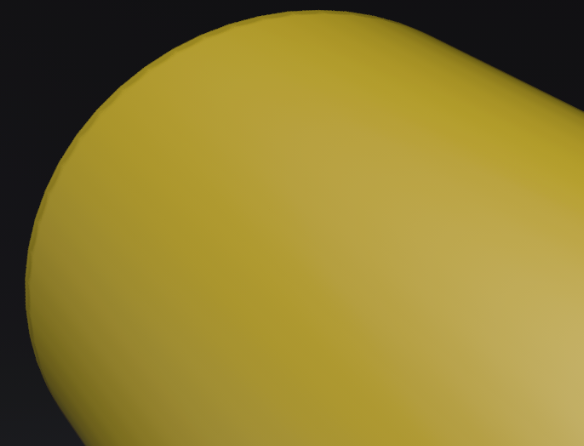
Use this limit to avoid the effect on edges already smoothed by the interpolation of the shading normals.

-
Quality - Sets the number of rays used to evaluate the nearest edges. Each quality level represents a multiple of 4 samples for estimating either convex or concave edges.
A quality level of 1 will trace 4 rays to estimate convex edges and 4 rays to estimate concave edges. At quality level 1, the effect is also only evaluated for non-distributed rays, not rays originating from diffuse or glossy brdfs. At higher quality levels, the effect is evaluated for one additional bounce.
Common
-
Occlusion Color - Sets the color of the pre-calculated ambient occlusion.
-
Occlusion Intensity - Sets the Substance's pre-calculated ambient occlusion intensity.
-
Sort Key (OnlyGL) - Enables the Substance to be sorted into groups based on the key that controls the order of the drawing transparent surfaces.
-
Environment - Right-click opens a context menu to select the HDR image to be used as light source.
-
Lighting Mode - Defines the light model to be used for the Substance. There are five different lighting models.
-
IBL + Indirect + Direct Lights - The Substance is affected by the HDR image, by the pre-calculated or interactive Global Illumination rendering and by the direct light sources placed in the scene.
-
IBL + Indirect - The Substance is affected by the HDR image and by the pre-calculated or interactive Global Illumination rendering.
-
IBL + Direct Lights - The Substance is affected by the HDR image and the direct light sources placed in the scene.
-
IBL - Only the HDR image affects the Substance.
-
Direct Lights - Only direct light sources placed in the scene affect the Substance.
-
-
Variable Rate Shading
Important:This is an OpenGL-specific rendering feature.
Use for content adaptive variable rate shading (shading rate per material). Enable either via Foveated HMD rendering or Visualization > Realtime Antialiasing > Variable Rate Shading.
For materials with fine patterns that are prone to the moiré effect, such as carbon or HMI textures with thin lines that appear aliased, use a supersampling shading rate (2 Samples, 4 Samples, or 8 Samples).
If you are looking for better performance, use the coarse shading rates (1 Sample per 4 Pixels/16 Pixels), which have no other purpose than that. Both of these can be used in VR and desktop mode.
E.g., all materials are rendered "normally" with the native shading rate (1 Sample), but the carbon material should be rendered with supersampling (4 Samples).
When using foveated rendering at the same time, the material is always rendered with its custom shading rate. For example, the carbon material is rendered with 4 samples on the whole screen, as well as in the periphery of the foveated area.
-
Off - Disables variable rate shading.
-
1 Sample - Enables variable rate shading for normal pixel shading, but no visual difference to VRS off.
-
1 Sample per 4 Pixels - Enables variable rate shading for coarse pixel shading with 1 sample per 4 pixel. Shaders with lower shading qualities are evaluated less often. The result of a material evaluation is used for multiple pixels (e.g., 1 Sample per 4 pixels is a coarse shading with 1 sample per 2x2 pixel block).
-
1 Sample per 16 Pixels - Enables variable rate shading for coarse pixel shading with 1 sample per 4x4 pixel box.
-
2 Samples - Enables variable rate shading for supersampled pixel shading with 2 samples per pixel. Materials are evaluated up to 2 times per pixel.
Important:This mode requires Realtime-Antialiasing to be enabled with a minimum corresponding multisampling sample amount.
-
4 Samples - Enables variable rate shading for supersampled pixel shading with 4 samples per pixel. Materials with higher shading qualities are evaluated up to 4 times per pixel.
Important:This mode requires Realtime-Antialiasing to be enabled with a minimum corresponding multisampling sample amount.
-
8 Samples - Enables variable rate shading for supersampled pixel shading with 8 samples per pixel. Materials with higher shading qualities are evaluated up to 8 times per pixel.
Important:This mode requires Realtime-Antialiasing to be enabled with a minimum corresponding multisampling sample amount.
-